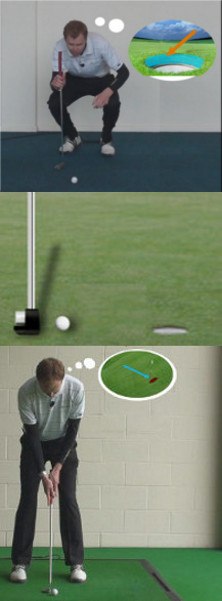
Oh man, we have finally reached the worst mental battle in the entire game of golf. If you have played golf long enough, then you have battled the yips at some point in your career… and if you say no, then you are not being honest with yourself. The yips can come up at any time, without any notice at all. You can be putting absolutely amazing throughout a round, then you reach the 15th hole… and you miss a three foot putt, and there it is, you begin to yip it for the final few holes. I had to fight this in a recent tournament, and I can honestly say it is not fun at all. No matter what you do, in the back of your mind, that miss is lingering and you can’t get it out of your head. Well, today we will cover the “yip” and what you can do to correct the flaw, and prevent it from occurring in the future.
The first thing I want you to do, is trust your stroke and please don’t immediately move to switching putters. This will actually set you back in your progress, and I hate to admit it, but it is not the putters fault. The yips actually start as a mechanical mistake in your stroke, and in time, turn into a mental mistake as well. The main error in your stroke relies in your hands. When you drive the handle of your putter forward with too much force at the start of the down stroke, this will cause the putter to lag behind the hands. This can actually cause an error that immolates getting your hands too far out in front during your normal golf swing. The putter head will get behind the ball, and you will end up pushing the putt away from the hole. On longer putts you have more time to catch the putter head back up, which is why you don’t see long putts miss the intended target line as often. The short putts require much better wrist movement – ultimately zero – and the tiniest bit of movement can move the ball just enough to miss the target line. On shorter putts, the misses are much more obvious, usually because you are closer to the hole and expect to make the putt. To eliminate the wrist movement, I suggest trying the claw grip. This was designed for those that tend to use the wrists too often during the putting stroke, and after some practice time, you can see some really great stuff here. The claw allows your right hand to be in a more “pushing” type motion, while your left hand keeps the club stable throughout. I don’t suggest that you try this for a few minutes and then abandon it. Any time you make a tweak to your putting, you need to truly invest a lot of time to perfecting the new motion. The claw grip does feel very different at first but with the correct amount of time dedicated to it, you will find yourself becoming more and more comfortable, and ultimately making more putts throughout your round.
Now that we have covered what causes the yips, and what you can apply to correct them… what is the most important thing to avoid when the yips occur? Do not abandon the putter you are currently using, and do not change the putter grip on the club. Most people believe that the putter is the issue, or the grip is not working for them. This is false, and if you don’t believe me, then sit back and think about all the putts you did make with this putter. The putter is not the problem at this point, it is all upstairs… in your head. The yips are honestly 90% mental. If you are a half-way decent putter, then you are going to use the same putting stroke on the majority of your putts all the time. You rarely will stray away and have a flawed stroke… until your brain starts working against you. The pushing flaw we discussed earlier, comes from between the ears. When you start thinking too much and get too hung up on the last putt you missed, your brain will be your worst enemy… and the yips will follow.
I will leave you with one main challenge whenever you are fighting the yips: Stick to the same putter you have been using, and do not abandon what has worked for so long. Don’t start “tinkering” with different grips and clubs, but stick to what has been so strong for you in the past. You can tweak your putting style however you want, but stick with the same grip and stick with the same putter… trust me, focus on the mental aspect of your putting and you will be just fine.





